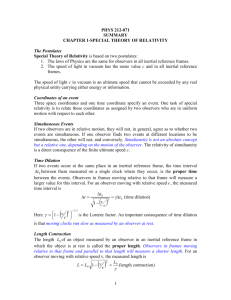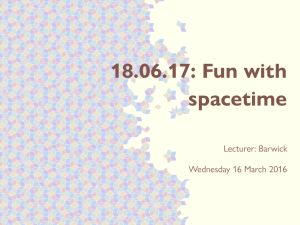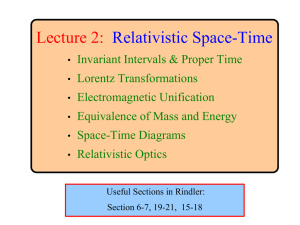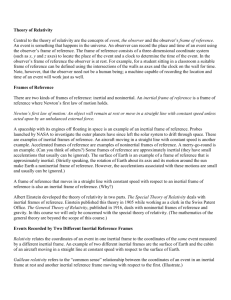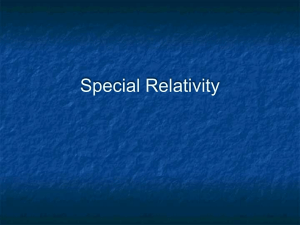PPT
advertisement
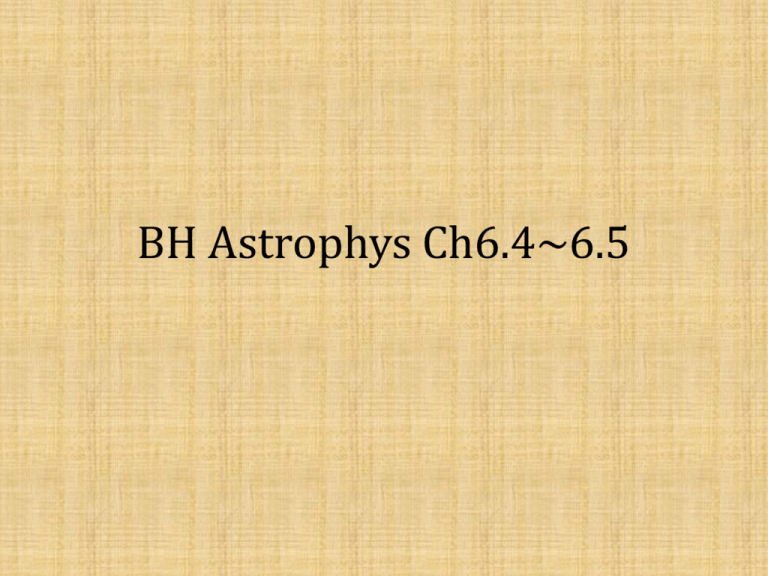
BH Astrophys Ch6.4~6.5 The need to rethink space and time Any such beam of any kind of particles generated at the speed of light by a moving observer would be received by a stationary observer at that same speed – regardless of how fast the two observers were moving relative to one another. How could the old Galilean view of space and time work to explain this? Apparently, it couldn’t! We need to change our view of space and time! Note: the Lorentz transformations came way before this deeper insight of geometry started to take hold. A note of history The views of space and time which I wish to lay before you have sprung from the soil of experimental physics, and therein lies their strength. They are radical. Henceforth space by itself, and time by itself, are doomed to fade away into mere shadows, and only a kind of union of the two will preserve an independent reality. – Hermann Minkowski, 1908 The line element in spacetime Previously, in 3D Euclidian geometry, we learned that dl2 = dx 2 + dy 2 + dz 2 is invariant under coordinate transformations. Considering space and time together and taking into account that the speed of light must be constant in any frame, we find that the new line element to satisfy such conditions is ds2 = −𝑐 2 d𝑡 2 + dx 2 + dy 2 + dz 2 Verification: Let a photon travel along the x direction. Given that we have two observers (A&B) with different velocities along the x axis, For A, the line element is then ds 2 = −𝑐 2 d𝑡 ′2 + 𝑐 2 d𝑡′2 = 0 For B, the line element is still ds 2 = −𝑐 2 d𝑡 2 + 𝑐 2 d𝑡 2 = 0 This is because both of them see the photon traveling at c ! An interesting fact about this is that photons apparently travel along what is called null geodesics, the line elements are 0 in any frame! A twist in ideas One other interesting property that follows directly by considering the following line element ds 2 = −𝑐 2 d𝑡 2 + dx 2 + dy 2 + dz 2 Is that even when we are apparently sitting still, given that some time dt has elapsed, then we have already traveled by an interval square of ds2 = −𝑐 2 d𝑡 2 ! So much for ‘common sense‘ of ‘not moving’! Based on the idea of line elements, we must also be able to derive the findings using pure algebra as were first during the development of special relativity. Namely, we should derive: 1. The effect of Time Dilation 2. The effect of FitGerald Contraction (or Lorentz Contraction) 3. The Lorentz Transforms Time Dilation Let’s again consider two observers, A&B. To simplify the problem, we only consider x-directional motion. Let’s have A sit still in some jet moving with const. velocity v in the +x direction w.r.t B, then, For A, she would observe herself only traversing in time, therefore, ds2𝐴 = −𝑐 2 dt 2 As for B, he would observe the interval as ds 2 𝐵 = −𝑐 2 dt′2 + 𝑣 2 dt′2 Assuming intervals are invariant, (we haven’t proven that the invariance of intervals gives the correct Lorentz transforms yet) ds2𝐴 = ds2 𝐵 This then gives dt ′ = Which is the time dilation formula. dt 𝑣 1− 𝑐 2 ≡ 𝛾dt FitGerald Contraction Some reminders Postulates of special relativity: 1. The laws of physics are the same in all inertial frames of reference 2. The speed of light in free space has the same value c in all inertial frames. On the Minkowski metric: (6.41) ds 2 = −𝑐 2 d𝑡 2 + dx 2 + dy 2 + dz 2 Spacetime diagrams Any event that you can affect lies in your future light cone. Trajectory of a particle Future Future light cone Now Events outside these light cones are inaccessible to you. Past light cone Past ds2 < 0 timelike intervals > 0 spacelike intervals ds2 = 0 lightlike intervals ds2 Any event that has the chance of affecting you at this very moment lies in your past light cone. Our trajectory in spacetime. The light from the Sun finally catches up with the spaceship. Trajectory of a spaceship moving away from Earth in direction opposite from the Sun. We are here right now. Assume that we don’t move about. Example Our trajectory intersects with the Sun’s future light cone – we see the light from the Sun that is emitted ‘now’ 8 minutes ‘later.’ The Sun’s future light cone. The Sun right now. It’s 8 light minutes away, what happens over there right now is not going to affect us till 8 minutes later. Different inertial frames To illustrate different observers situated in different inertial frames, it is convenient to overlay spacetime diagrams as seen by two different observers. It will also form the basis of our derivation of Lorentz Transformations using the spacetime diagram. In the last few slides we just simply drew the spacetime diagram without discussing what exactly we mean by x axis and t axis. t’ t First, the t axis: As we have shown, when we are not moving, then our path corresponds to the t axis. Or in 𝜃 general, the t axis is the trajectory of the tanθ = 𝛽 observer which perceives himself as stationary. x Thus, for an observer that we see a moving in the +x direction, his t’ axis would be his trajectory. Different inertial frames How about the x axis? The x axis basically shows all events that happen at the same time. How then do we draw the line that corresponds to events of which in the moving observer’s frame are at the same time? A more formal way can be found in Schutz but here is a very simple illustration: t t’ Consider the Sun to be at a distance x away in our frame. tanθ = 𝛽 For an observer moving toward it in a spaceship at velocity 𝛽 (=v/c), it would 1 𝑋 only take light the time of to reach the spaceship. As light always travels 𝑐 1+𝛽 along the null geodesics, the point which should be registered as “the Sun right 𝑋 now” for people on the spaceship therefore must be at a distance as seen 1+𝛽 in our frame. The Sun ‘now’ for the spaceship. x’ It is then easy to work out that the angle between the x and x’ axes is also 𝜃 by considering the light ray. 𝜃 𝜃 x 𝑋 1+𝛽 The Sun ‘now’ in our frame. X One must take caution that the above arguments are done in our frame of reference, people on the 1 𝑋 spaceship won’t think it took time for the 𝑐 1+𝛽 light from the Sun to reach them. The Lorentz transformations t′ = γt − βγx 𝐿= 𝛾 −βγ 0 0 x′ = −βγt + γx −βγ 𝛾 0 0 0 0 1 0 0 0 0 1 Proper time In classical physics, we had defined 𝑣 = dx ;𝑎 dt = dv dt However, now that time itself isn’t some universal quantity. It becomes necessary to discuss what we should use to replace the ‘dt’ term with. Apparently, it would be not such a good idea to use dt to define some more universal ‘velocity/acceleration’ which works in 4 dimensions since dt itself is subjected to change when we go to other frames of reference. t Therefore, we define the quantity called ‘Proper time dτ’ as : Given two timelike events, the proper time is the time between the two events as measured by a stationary observer that passes through them. event A t’ event B dτ x’ x 4-vectors The Lorentz Transforms were used for transforming the 4-displacement (i.e. coordinates in 4D) in-between different inertial frames of reference. Therefore, we can define a class of objects called ‘4-vectors’ written as 𝐴𝜇 to have the property : 4-vectors follow the same transform as the coordinates transform. The most basic 4-vector is of course 𝑥 𝜇 = (𝑐𝑡, 𝑥, 𝑦, 𝑧). It obviously transforms from one coordinate to another by means of Lorentz Transforms as we’ve found. A simple extension would be to define 𝑈 𝛼 ≡ 𝑎𝛼 ≡ dU𝛼 , dτ dx𝛼 , dτ which we call the ‘4-velocity’ and which we call ‘4-acceleration’. Both of them also transform in-between coordinates like the 4-displacement 𝑥 𝜇 . This is because we have defined dτ, the proper time to be a scalar quantity, i.e. it is a quantity that doesn’t change with coodinates. Examples 𝛼 Defining 𝑈 ≡ dx𝛼 dτ 𝛼 and 𝑎 ≡ dU𝛼 , dτ it would be useful to see what they look like in 4-form. Consider a moving spaceship with const. velocity Then, for people on it, they would consider themselves as stationary, meaning that their displacement is only d𝑥 𝜇 = 𝑐dτ, 0,0,0 𝛾 +βγ 0 0 +βγ 𝛾 0 0 𝐿= *the bar symbol is for moving frame 0 0 1 0 0 0 0 1 Therefore, 𝑈 𝛼 = (𝑐, 0,0,0) and 𝑎𝛼 = (0,0,0,0) If we transform 𝑈 𝛼 to 𝑈 𝛼 by using 𝑈𝛽 = 𝛬𝛽 𝛼 𝑈 𝛼 , then we find 𝑈 𝛼 = (γc, γ𝑣, 0,0) Which looks familiar… except with some extra γ s in there. Where are they from? Example (cont.) dx𝛼 dτ 𝛼 dx Remember that 𝑈 ≡ but our classical velocity is 𝑣 = dt ! So we need to find the relation between dt and dτ. From time-dilation, that would be dt = γdτ dx𝛼 d𝑡 dτ Thus, = 𝑈 𝛼 d𝑡 = (c, 𝑣, 0,0) which is exactly the trajectory that we drew for a moving spaceship on the spacetime diagram. t t’ event B dτ x’ event A x The magnitude of 4-velocity Similar as in 3D case, the magnitude of 4-vectors can be found by 𝑔αβ 𝑈 𝛼 𝑈𝛽 = −𝑐 2 𝑔αβ = −1 0 0 0 0 1 0 0 0 0 1 0 0 0 is the metric in flat spacetime 0 1 Energy-momentum 4-vector Another quantity that follows quite straight forwardly from the 4-velocity is 4momentum. 𝑃𝛼 ≡ 𝑚0 𝑈 𝛼 ; 𝑃2 = −𝑚0 2 𝑐 2 𝑚0 the rest mass of the particle. Following previous example in which we see a spaceship to have 𝑈 𝛼 = (γc, γ𝑣, 0,0), 𝑃𝛼 = (γ𝑚0 𝑐, γ𝑚0 𝑣, 0,0) What is the first term in this vector? 1 1 By expanding to first order we see that γ𝑚0 𝑐 ≈ 𝑐 𝑚0 𝑐 2 + 2 𝑚0 𝑣 2 which simply is the rest mass energy plus the classical kinetic energy! Therefore, we usually generalize this concept to define 𝑃𝛼 = 𝐸 𝑥 , 𝑃𝑦 , 𝑃 𝑧 , 𝑃 𝑐 Combining with 𝑃2 = −𝑚0 2 𝑐 2 , we arrive at the equation 𝐸 2 = 𝑃2 𝑐 2 + 𝑚0 2 𝑐 4 Newton’s Law Similar with what we’ve done before, Newton’s Law 𝐹 = 𝐹𝜇 = dP𝜇 dτ Or in general, 𝐹𝜇 = 𝑈𝜇 𝑃𝛼 ,𝛼 ? dp dt in 4-form then is : The Doppler factor Just as in classical physics, waves exhibit Doppler shifts when viewed from frames with different velocities. We define the doppler factor δ through 𝑓 = δf0 For relativistic velocities, 𝛿 = 𝛾 1 1−𝛽cosθ Some cases: 1. Source moving toward observer at v~c 2. Source receding from observer at v~c 3. Sources not approaching nor receding 𝛿~2𝛾 1 𝛿~ 2𝛾 1 𝛿=𝛾 (time dilation) Importance in astrophysics
